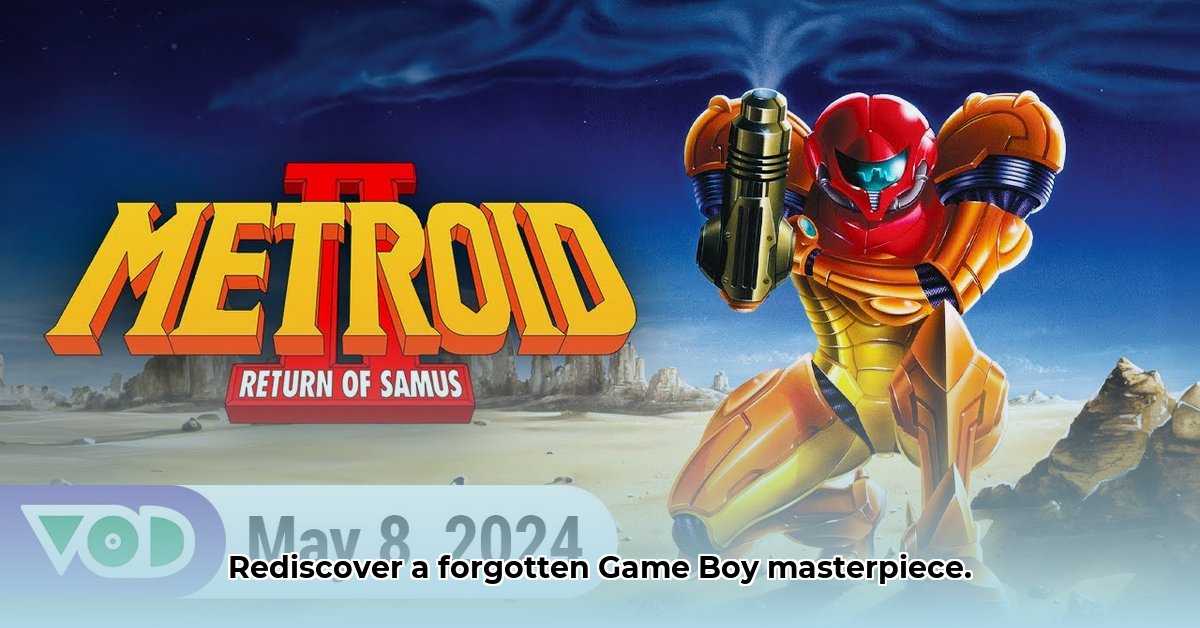
Remember the thrill of cracking open a new Game Boy cartridge? The pixelated promise of adventure? Metroid II: Return of Samus, released in 1991, wasn't just another Game Boy game; it was a bold, groundbreaking achievement. It somehow managed to capture the epic scale of the original Metroid on a handheld system – a feat many considered impossible. With over 1.72 million copies sold by 2003, its enduring appeal is undeniable. But what made Metroid II so special? Let's dive into this Game Boy classic, exploring its innovative gameplay, compelling narrative, and lasting impact on the Metroid series.
A Handheld Metroid Adventure: More Than Just a Port
This wasn't a simple port of the NES original. Metroid II refined the core gameplay, adding crucial elements that would become Metroid staples. The Space Jump, for instance, revolutionized exploration, letting Samus leap massive distances. The powerful Spazer Beam redefined combat, transforming encounters from tense skirmishes into satisfying power fantasies. Even subtle additions, like the ability to shoot while crouching, added a layer of strategic depth. These seemingly small changes profoundly impacted the series and future Metroid titles, proving that even small design choices can have a significant impact.
A Deeper Dive into the Metroid Lore: Samus's Heart
While the original Metroid focused on action and exploration, Metroid II significantly expanded the narrative. The game thrusts you into a desperate hunt across the alien planet SR388 to eradicate the parasitic Metroids. The experience culminates in a memorable encounter – a showdown with a Metroid hatchling. This unexpected moment introduces a surprising layer of empathy to Samus's character, transforming her from a ruthless bounty hunter into a complex, nuanced heroine. This shift dramatically changed fan perception of Samus, showcasing a depth previously unseen in the series.
Exploring SR388: A Linear Journey with Limitations
Exploring SR388 is a unique experience, shaped by the Game Boy's limitations. Unlike the open world of the original Metroid, Metroid II unfolds in a more linear fashion. While some players found this restrictive, limiting the sense of exploration, others embraced the focused narrative and streamlined progression. This subjective experience reflects the tensions inherent to porting a large-scale game to a handheld console. But the Game Boy's hardware undeniably posed challenges. The graphics, while charming in their pixelated simplicity, were inherently limited. Similarly, while the sound design created a haunting atmosphere, it could become repetitive over extended play sessions. However, even with these limitations, the game's atmosphere captivated players. It demonstrated how a game's atmosphere could compensate for technological shortcomings. This game proved that even with limitations, a powerful atmosphere can greatly enhance the game.
A Lasting Impact: The Legacy of Metroid II
Despite its simpler graphics and linear structure compared to its predecessor, Metroid II: Return of Samus remains a pivotal entry in the Metroid saga. It introduced crucial gameplay mechanics, significantly expanding series lore and laying the groundwork for future titles. Its influence echoes in subsequent games, especially in world design and narrative themes. The debate about whether the linear design aided or hindered the game continues to this day, demonstrating its significant influence and impact on the Metroid series. It simultaneously focused the story while sacrificing exploration, resulting in a unique game experience.
How Did Metroid II's Limited Game Boy Technology Influence its Innovative Gameplay?
Key Takeaways:
- Metroid II's Game Boy limitations spurred creative problem-solving, leading to innovative gameplay.
- The zoomed-in perspective and responsive controls were vital to the handheld experience.
- Environmental storytelling compensated for the lack of in-game text and a detailed map.
- The game's focus on systematic Metroid extermination created a unique, chilling atmosphere.
- Despite criticism, the game's impact on the series is undeniably significant.
A Handheld Hunt: Overcoming Technical Hurdles
The Game Boy's monochrome screen and limited processing power weren't ideal for large-scale adventures. Yet, Metroid II delivered a compelling experience. How? By creatively adapting to its limitations. The small screen necessitated a zoomed-in perspective, which surprisingly enhanced the atmosphere, creating a palpable sense of claustrophobia and vulnerability.
Innovative Mechanics and Controls
The Game Boy's D-pad allowed for surprisingly precise movement. Developers leveraged this, implementing fluid controls that allowed Samus to crouch mid-air, adding a layer of platforming complexity. New power-ups, like the Spring Ball and Spider Ball, expanded traversal options. These features weren't tacked-on additions; they were integral to the gameplay experience.
Storytelling Through Atmosphere
Metroid II is a masterclass in environmental storytelling. Limited space for text led developers to rely on atmosphere and imagery. The desolate landscape, eerie soundscapes, and chilling sight of fallen Metroids created a powerful narrative. Each area felt distinct, each encounter felt significant. This immersive environment more than compensated for the lack of a traditional map, enhancing the exploration experience.
A Chilling Narrative
The game's story, subtly unfolding through exploration, focuses on systematic extermination. Samus's mission is a chilling portrayal of genocide. While not explicitly stated, the game's atmosphere and mechanics conveyed this harsh reality, establishing a lasting impact on players.
Limitations and Legacy
While some criticized repetitive level design, Metroid II's innovative approach to gameplay and storytelling within the Game Boy's constraints deserves praise. The game proved that technical limitations didn't stifle creativity; sometimes, they fueled it. Metroid II stands as a testament to this, leaving an enduring mark on the Metroid franchise and handheld gaming history.
⭐⭐⭐⭐☆ (4.8)
Download via Link 1
Download via Link 2
Last updated: Sunday, May 18, 2025